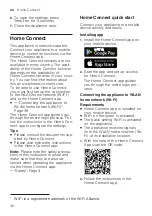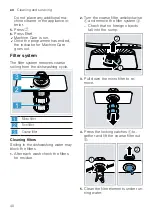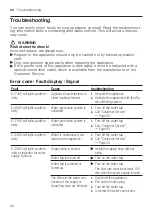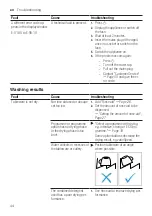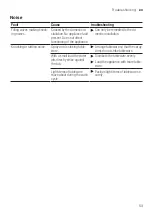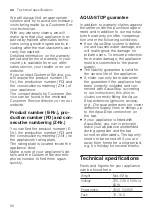
en
Troubleshooting
48
Fault
Cause
troubleshooting
Tea residue or lipstick marks
on tableware.
Too little detergent is being
used or is unsuitable.
▶
Use a suitable "Detergent "
turer's instructions for the amount
to be used.
Tableware has been pre-
cleaned too intensely. The
sensors chose a weaker pro-
gramme. Stubborn soiling
cannot be entirely removed.
▶
Only remove large remnants of food
and do not prerinse tableware.
Coloured coatings (blue, yel-
low, brown) that are difficult
or impossible to remove are
present inside the appliance
or on stainless steel table-
ware.
The formation of films is due
to substances contained in
vegetables (cabbage, celery,
potatoes, noodles, etc.) or
tap water (manganese).
▶
Clean the appliance.
You can remove deposits with
"Mechanical cleaning"
or a machine cleaning product. It
may not always be possible to com-
pletely remove deposits but they
are harmless to health.
The formation of films is due
to metal components on sil-
ver or aluminium tableware.
▶
Clean the appliance.
You can remove deposits with
"Mechanical cleaning"
or a machine cleaning product. It
may not always be possible to com-
pletely remove deposits but they
are harmless to health.
Coloured deposits (yellow,
orange, brown) that are easy
to remove are present inside
the appliance (mainly at the
bottom).
The formation of films is due
to ingredients of food rem-
nants and tap water (limes-
cale) "soaplike".
1.
Check the setting of the water
softening system.
2.
Add special salt.
"Adding special salt", Page 25
3.
If you are using combined deter-
gents (tabs), activate the water
softening system.
Follow the information about deter-
gents.
Plastic parts inside the appli-
ance are discoloured.
Plastic parts inside the appli-
ance may become discol-
oured during the life of the
dishwasher.
▶
Discolouration can come about and
will not impair functioning of the ap-
pliance.
Plastic parts are discol-
oured.
Washing temperature is too
low.
▶
Select a programme with a higher
washing temperature.



